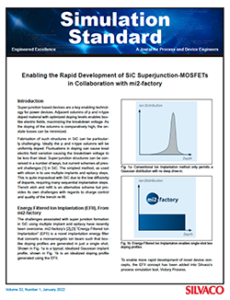Enabling the Rapid Development of SiC Superjunction-MOSFETs in Collaboration with mi2-factory
Introduction
Super-junction based devices are a key enabling technology for power devices. Adjacent columns of p and n-type doped material with optimized doping levels enables box-like electric fields, maximizing the breakdown voltage. As the doping of the columns is comparatively high, the on-state losses can be minimized.
Fabrication of such structures in SiC can be particularly challenging. Ideally the p and n-type columns will be uniformly doped. Fluctuations in doping can cause local electric field variation causing the breakdown voltage to be less than ideal. Super-junction structures can be conceived in a number of ways, but current schemes all present challenges [1] in SiC. The simplest method, as used with silicon is to use multiple implants and epitaxy steps. This is quite impractical with SiC due to the low diffusivity of dopants, requiring many sequential implantation steps. Trench etch and refill is an alternative scheme but provides its own challenges with regards to charge control and quality of the trench re-fill.



